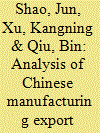| Srl | Item |
| 1 |
ID:
113693


|
|
|
|
|
| Publication |
2012.
|
| Summary/Abstract |
This paper studies the duration of Chinese manufacturing exports and its determinants, using disaggregated 6-digit level Harmonized System product trade data from 1995 to 2007. Cox proportional hazard, Weibull and exponential models are used to examine the effects of various factors on export duration. It is revealed that export duration tends to be rather short-lived. It is also found that GDP and GDP per capita of the export destination have positive effects on export duration, while trade relationships with distant and landlocked countries are generally of shorter duration. In addition, export duration is longer for differentiated and parts and components products, as well as products with large initial trade values. WTO membership is also important for longer export duration. Our empirical analysis suggests that developed markets, such as the USA and the EU, are important to China, and should still be the major sources for Chinese export growth in the long run. Moreover, technical innovation of firms and free trade agreement negotiations will be helpful for sustainable export growth.
|
|
|
|
|
|
|
|
|
|
|
|
|
|
|
|
| 2 |
ID:
148694


|
|
|
|
|
| Summary/Abstract |
China, as an important source country in the global value chain, especially in the East Asian production networks, has exerted significant influence on Sino–Japanese trade fluctuations. This paper explores the real factors that lead to the fluctuations in Sino–Japanese trade. Using the Hodrick–Prescott filter technique and OECD–WTO Statistics on Trade in Value Added from 1995 to 2011, the impact of the changing comparative advantage between the two countries is also examined. The empirical results indicate that determinants of the fluctuations in Sino–Japapese trade include changing comparative advantages, the volatility of the real exchange rate and quite a few external shocks. Some policy suggestions are put forward in regards to the stability of trade between the two countries.
|
|
|
|
|
|
|
|
|
|
|
|
|
|
|
|